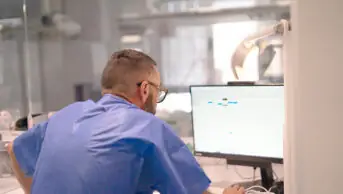Distance-selling pharmacies (DSPs), more commonly known as online pharmacies, have been steadily growing in number over the past couple of decades, since the first one — market leader Pharmacy2U — was established in 1999. A combination of the 2005 exemption, allowing online pharmacies to avoid market entry criteria, along with the more recent move from paper to electronic prescriptions, saw the number of DSPs reach 400 by the end of 2023 (see Figure 1). This increase in DSPs since 2016, when the NHS Business Services Authority first started to record them as such on its systems, is in contrast to a net loss of bricks-and-mortar pharmacies over the same period.
DSPs are contractually obligated to provide their services and deliver prescriptions to customers anywhere in England (see Box).
However, an investigation by the Company Chemists’ Association (CCA) in 2023 revealed that 72% of DSPs were breaching their NHS contracts by only operating within small geographical areas.
The CCA found that these “pseudo-DSPs” were receiving more than 50% of their prescriptions from GPs in a single postcode area within 10 miles of the pharmacy.
“Genuine DSPs offer valuable access to medicines and greater choice for patients. However, pseudo-DSPs continue to disrupt the market, putting local contractors under pressure and potentially denying patients access to wider pharmaceutical care,” said Malcolm Harrison, chief executive of the CCA, in February 2024.
The CCA is calling for NHS England to revoke the contracts of DSPs that continue to fail to meet their contractual requirements.
What is a distance-selling pharmacy?
- Distance-selling pharmacies (DSPs) are pharmacies that provide services at a distance, including online, rather than in the traditional face-to-face ‘bricks and mortar’ setting;
- DSPs are not allowed to offer essential services to customers at the registered pharmacy premises or in the vicinity;
- DSPs must have procedures in place to offer uninterrupted provision of essential services, such as dispensing medicines, during their opening hours to customers anywhere in England;
- DSPs are not allowed to be co-located with a provider of primary medical services with a patient list;
- DSPs may provide advanced and enhanced services, such as the new medicines service, Pharmacy First and influenza vaccinations, on the premises, as long as any essential service which forms part of the advanced or enhanced service is not provided to persons present at the premises;
- Nothing in any written or oral communication can suggest, either expressly or implied, that services will only be available to persons in particular areas of England, or only particular categories of patients will (or will not) be provided for;
- DSPs must ensure that they have a website for use by the public for the purpose of accessing pharmaceutical services from those premises, which must have an interactive page that is clearly promoted when they first access the website. This page must provide access to a reasonable range of up-to-date materials that promote healthy lifestyles and address a reasonable range of health issues;
- DSPs are exempt from market entry requirements that apply to bricks-and-mortar pharmacies.
Source: Community Pharmacy England
Patient nominations have slowed
DSPs gained popularity during the COVID-19 pandemic, with the number of people nominating DSPs as their chosen pharmacy almost doubling from 999,498 at the beginning of the pandemic, in March 2020, to 1,950,497 in March 2022. However, since then, the number of people nominating DSPs has slowed dramatically, increasing by only 4% (84,269) over the past two years, to reach 2,034,766 in February 2024 (see Figure 2).
That level of growth was never going to last
Conor Daly, a partner at Rushport Advisory
“Whilst the pandemic caused a spike in patients using DSPs, as it did for all online services, that level of growth was never going to last,” Conor Daly, a partner at Rushport Advisory, a consulting firm covering the pharmacy market, tells The Pharmaceutical Journal.
Nominations for the five most popular DSPs are continuing to grow but at a slower rate than during the pandemic (see Figure 3). The most popular DSP, Pharmacy2U, gained 244,389 nominations during the first 2 years of the pandemic, between March 2020 and March 2022, but just over half as many — 136,676 nominations — over the following 2 years to February 2024.
The second most popular DSP, LloydsDirect, gained 455,035 nominations between March 2020 and March 2022, but only 20,201 nominations over the following two years. Daly puts this down to the sale of all LloydsPharmacy branches, which were used to recruit patients for the online business.
Daly also points out that larger DSPs have a significant “churn” of patients, “so the number of new patients as a percentage is likely to be [higher] but this adjusts down when you take into account patients who leave for whatever reason”.
LloydsDirect was purchased by Pharmacy2U in October 2023, but the two companies are continuing to operate separately while the merger is investigated by the Competition and Markets Authority to consider whether it will result in a substantial lessening of competition in the market.
Prescription item growth
Although the number of prescription items dispensed by all DSPs continues to increase, this too has slowed slightly since the pandemic years (see Figure 4). For the first 18 months of the pandemic, the number of monthly items increased by 57%, rising from 3,014,918 items in March 2020 to 4,720,042 items in November 2021. Whereas, in the most recent 18 months of available data — between March 2022 and November 2023 — the increase was only 20%.
Over the same periods, the number of prescription items dispensed by all community pharmacy contractors in England remained fairly consistent, falling by 3% over the first 18 months and increasing by 3% over the 18 months to November 2023.
The proportion of all prescription items dispensed by DSPs is still relatively low, at just over 6%, with Pharmacy2U responsible for around 1.7% of all prescription items dispensed by community pharmacy contractors in England as of November 2023 (see Figure 5).
Making a loss
Like bricks-and-mortar community pharmacy contractors, some DSPs are finding it hard to make a profit. Despite its growth, Pharmacy2U, for example, made a pre-tax loss of £5.6m in the year to March 2023. And, according to its most recent financial accounts, LloydsDirect made a pre-tax loss of £10.2m to March 2022 (see Figure 6).
Daly points out that large DSP operators have a “massive spend” on advertising to attract customers and then another massive spend on infrastructure and automation to support the growth.
“Smaller DSPs tend to do much better as they do not spend money in the same manner and often have lower cost models. For example, providing prescriptions to nursing homes can mean one delivery that covers hundreds of prescription items and without marketing costs,” he explains.
Clinical services growth
As dispensing growth has slowed, some DSPs have begun to start providing more clinical services, with Pharmacy2U becoming the biggest provider of the new medicine service (NMS) in November 2023, declaring 1,920 interventions, up from 0 in November 2022 (see Figure 7).
Pharmacy2U is also providing Pharmacy First, which launched in England on 31 January 2024, offering diagnosis and treatment for six of the seven common conditions covered by the service. The service will be provided via video call, with any medicines posted for free using Royal Mail’s tracked 24-hour service.
Darren Powell, chair of the Royal Pharmaceutical Society’s Digital Pharmacy Expert Advisory Group and clinical lead for the NHS England Transformation Directorate, believes that inclusion of DSPs in the Pharmacy First scheme “is a clear signal that government believe they can help deliver on the primary care recovery plan, along with the traditional community pharmacy sector”.
Some patients will appreciate the ability to seek advice via their mobile devices
Darren Powell, chair of the Royal Pharmaceutical Society’s Digital Pharmacy Expert Advisory Group
He tells The Pharmaceutical Journal: “A number of individuals in the profession have criticised this move, citing the urgent need of antibiotics and the requirement of the DSPs to supply via various ‘delivery’ mechanisms. But I think they’ve missed the point about providing access to a trained healthcare professional (pharmacist) and triaging patients appropriately. Some patients will appreciate the ability to seek advice via their mobile devices, and have video consultations, rather than attending face-to-face appointments.”
Daly points out that NHS advanced and enhanced services, as well as private services, can, in the most part, be provided face-to-face by DSPs or can be provided within other settings, such as nursing homes. “COVID vaccination clinics were a good example of this, with many DSPs providing the service.”
He believes that the more successful DSPs are operated by people who have a plan to attract patients and who also provide private services to patients outside of the NHS. “The NHS patient base is then similar to a customer base and those customers may require non-NHS services.”
Powell says that, although it is a time of consolidation and readjustment in the DSP sector, he still expects continued growth “as the bricks-and-mortar numbers continue to decline, and ownership distributions change”.
Daly agrees: “I do not consider the market to be saturated. In fact, it is still in its infancy.”



